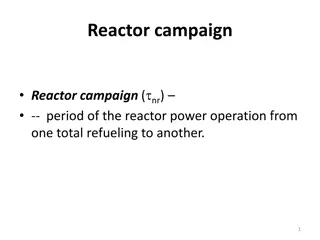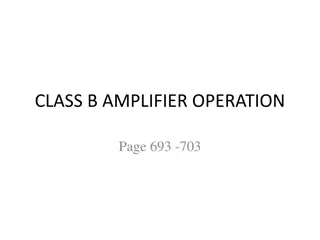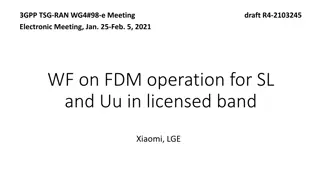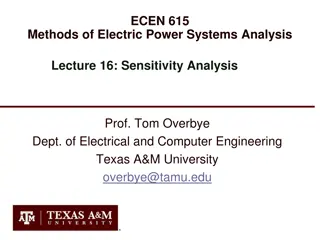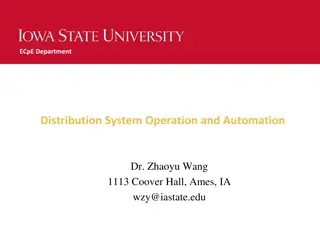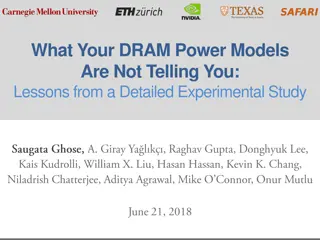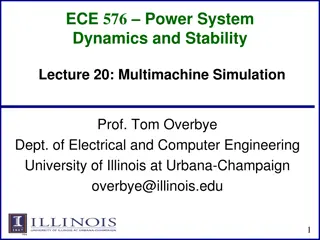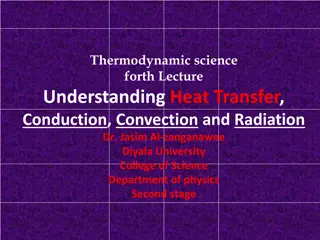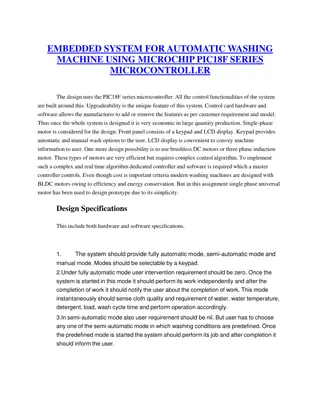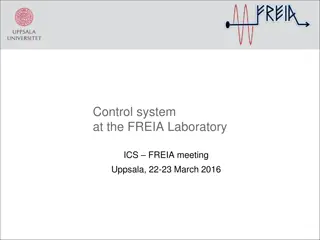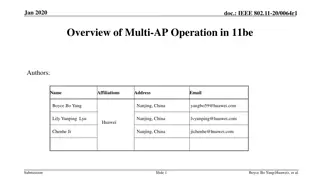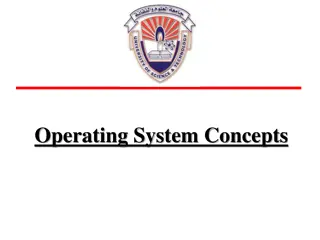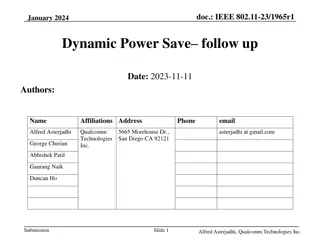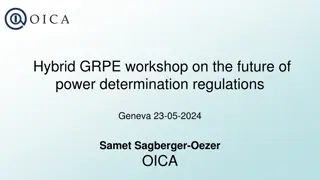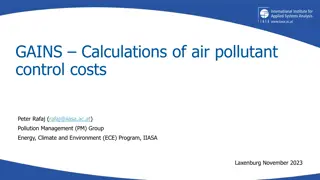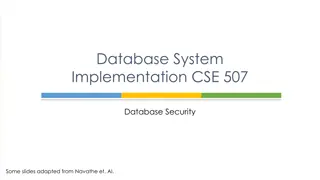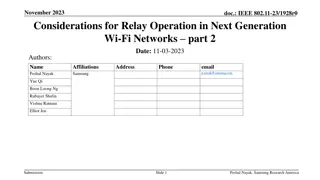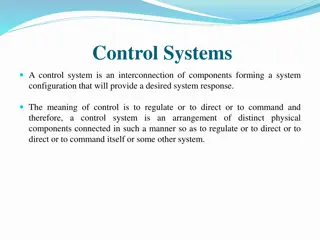Power System Operation and Control: Lecture 13 Highlights
This lecture covers power flow, contingency analysis, and power system control in-depth. It discusses assumptions, load variations in a synthetic grid, and design cases for serving new loads. The importance of contingency analysis and solving large power systems efficiently is emphasized.
Download Presentation

Please find below an Image/Link to download the presentation.
The content on the website is provided AS IS for your information and personal use only. It may not be sold, licensed, or shared on other websites without obtaining consent from the author. Download presentation by click this link. If you encounter any issues during the download, it is possible that the publisher has removed the file from their server.
E N D
Presentation Transcript
ECEN 460 Power System Operation and Control Lecture 13: Power Flow, Contingency Analysis, Power System Control Prof. Tom Overbye Dept. of Electrical and Computer Engineering Texas A&M University overbye@tamu.edu
Announcements Finish reading Chapter 6 Homework 5 is 6.38 (except change the line s impedance to 0.02+j0.08), 6.39 (except use the 0.02+j0.08 line impedance, and just do one iteration), 6.44, 6.48, 6.52, 6.53 Lab 6 and the following labs will be back in WEB 115 1
Assumed Load Variation in 500 Bus South Carolina Synthetic Grid In response to the question about the assumed load variation in the 500 bus grid, here is the data. The source was FERC 714 data (which is public utility data). 2
Contingency Analysis Contingency analysis provides an automatic way of looking at all the statistically likely contingencies. In this example the contingency set is all the single line/transformer outages 3
Design Case 1: Serving New Load SLA CK345 A 19% MVA A 29% MVA 221 MW 66 Mvar 1.02 pu PINE345 slack A A A 38% MVA 39% MVA 25% MVA 1.02 pu SLA CK138 OA K345 1.01 pu PINE138 A A 46% MVA 15% MVA 1.03 pu A 17% MVA OA K138 1.00 pu 38 MW 15 Mvar A 1.02 pu 54% MVA Assume we need to serve a new 70 MW, 20 Mvar load at 69 kV 15.9 Mvar 21 MW 6 Mvar A A 1.02 pu PINE69 38% MVA 38% MVA 60 MW 19 MW 3 Mvar A A 1.02 pu OA K69 BUCKEYE69 16 Mvar 43% MVA 36% MVA 1.01 pu A 26 MW 10 Mvar 29% MVA 1.01 pu A PPLE69 A A 60% MVA A PA LM69 MVA 1.00 pu WILLOW69 A MVA 22% MVA 24 MW 0 Mvar A SH138 A 35% MVA MA PLE69 Total Losses: 12.11 MW A 8.1 Mvar 45% MVA 14 MW 6 Mvar A 46% MVA 22 MW 9 Mvar 1.00 pu PLUM138 0.99 pu CEDA R138 A ORA NGE69 16% MVA A LOCUST69 46% MVA 1.00 pu A A WA LNUT69 66 MW 46 Mvar 29% MVA 74% MVA 35 MW 12 Mvar 59 MW 19 Mvar 42 MW 12 Mvar 1.01 pu CEDA R69 A 35% MVA 28.9 Mvar PECA N69 1.00 pu 1.02 pu 14.4 Mvar 180 45 Mvar MW 1.00 pu 64 MW 12.7 Mvar A 19% MVA A 14 Mvar 52 -14 Mvar MW 56% MVA A A 19% MVA 49% MVA A 19% MVA 67 MW 42 Mvar A A 24% MVA 1.000 pu 51% MVA PEA R138 1.00 pu 1.00 pu MA PLE69 A A 44% MVA OLIVE69 51% MVA A TULIP69 POPLA R69 25 MW 8 Mvar 31% MVA 7.6 Mvar A 19% MVA 1.01 pu A PEA R69 49% MVA 1.01 pu A 15% MVA 18 MW 7 Mvar 44 MW 12 Mvar A SPRUCE69 106 55 Mvar MW 47% MVA 0 MW 0 Mvar A 1.01 pu 50% MVA A 26% MVA 42 MW 12 Mvar 1.00 pu A A 42% MVA 41% MVA A 69 MW 14 Mvar 7.2 Mvar A MVA 1.00 pu 0.99 pu CHERRY69 0.0 Mvar MVA A A 13% MVA 50 MW 0 Mvar 42 MW 4 Mvar BIRCH69 45% MVA 1.00 pu REDBUD69 PEA CH69 1.02 pu 27 MW 7 Mvar 26 MW 17 Mvar 10 5 Mvar MW 16 MW 0 Mvar A A A 143 24 Mvar MW 32% MVA 33% MVA 51% MVA 0.99 pu ELM138 ELM345 PEA CH138 1.01 pu LEMON69 1.00 pu 1.00 pu TULIP138 A 58% MVA A A 44% MVA 150 2 Mvar MW 1.01 pu LEMON138 MVA A A 23% MVA 55% MVA 150 2 Mvar MW A 30% MVA 1.03 pu 1.02 pu A 44% MVA 4
Solving Large Power Systems The most difficult computational task is inverting the Jacobian matrix inverting a full matrix is an order n3 operation, meaning the amount of computation increases with the cube of the size this amount of computation can be decreased substantially by recognizing that since the Ybus is a sparse matrix, the Jacobian is also a sparse matrix using sparse matrix methods results in a computational order of about n1.5. this is a substantial savings when solving systems with tens of thousands of buses We ll return to large systems once we cover economic dispatch and optimal power flow 5
Modeling Voltage Dependent Load So far we've assumed that the load is independent of the bus voltage (i.e., constant power). However, the power flow can be easily extended to include voltage depedence with both the real and reactive l is done by making P and Q a function of oad. This V : Di Di i n + + = ( cos sin ) ( ) 0 V V G B P P V i k ik ik ik ik Gi Di i = 1 k n + = ( sin cos ) ( ) 0 V V G B Q Q V i k ik ik ik ik Gi Di i = 1 k 6
Voltage Dependent Load Example In previous two bus example now assume the load is constant impedance, so 2 = ) 2.0 + = x P ( ) (10sin 0 V V 2 2 2 2 2 2 = ( 10cos + (10) 1.0 + = ( ) x ) 0 Q V V V 2 2 2 2 2 Now calculate the power flow Jacobian 10 ( ) 10 2 V + + cos sin 10sin 4.0 V V V + 2 2 2 20 2 2.0 = x J 10cos V 2 2 2 2 7
Voltage Dependent Load, cont'd 0 1 (0) = = x Again set 0, guess v Calculate 2 ) 2.0 + (10sin V V 2.0 1.0 2 2 V 2 + (0) = = x f( ) 2 2 ( 10cos + ) (10) 1.0 V V 2 2 2 2 10 0 4 (0) = J x ( ) 12 1 0 1 10 0 4 2.0 1.0 0.1667 0.9167 (1) = = x Solve 12 8
Voltage Dependent Load, cont'd With constant impedance load the MW/Mvar load at bus 2 varies with the square of the bus 2 voltage magnitude. This if the voltage level is less than 1.0, the load is lower than 200/100 MW/Mvar 160.0 MW 120.0 MVR -160.0 MW -80.0 MVR Line Z = 0.1j 0.894 pu -10.304 Deg One 1.000 pu Two 160.0 MW 120.0 MVR 160 MW 80 MVR 9
Dishonest Newton-Raphson Since most of the time in the Newton-Raphson iteration is spend calculating the inverse of the Jacobian, one way to speed up the iterations is to only calculate/inverse the Jacobian occasionally known as the Dishonest Newton-Raphson an extreme example is to only calculate the Jacobian for the first iteration ( 1) ( ) Honest: + = x x + ( ) -1 v ( ) v v v = x x - ( J x f x ) ( ) ( 1) ( ) v (0) -1 ( ) v v - ( J x f x Dishonest: ) ( ) ( ) v for a solution f x Both require ( ) 10
Dishonest Newton-Raphson Example Use the Dishonest Newton-Raphson to solve 2 = = ( ) f x -2 0 x 1 (0) ( dx ) df x ( ) v ( ) v = ( ) x f x 1 x ( ) v ( ) 2 v = (( ) -2) x x (0) 2 1 x + ( 1) ( ) v ( ) 2 v v = (( ) -2) x x x (0) 2 11
Dishonest N-R Example, contd 1 x + ( 1) ( ) v ( ) 2 v v = (( ) -2) x x x (0) 2 We pay a price in increased iterations, but with decreased computation per iteration (0) = Guess x 1. Iteratively solving we get ( ) v ( ) v v 0 1 2 3 4 (honest) 1 1.5 1.41667 1.41422 1.41422 (dishonest) 1 1.5 1.375 1.429 1.408 x x 12
Two Bus Dishonest ROC Slide shows the region of convergence for different initial guesses for the 2 bus case using the Dishonest N-R Red region converges to the high voltage solution, while the yellow region converges to the low voltage solution 13
Honest N-R Region of Convergence Maximum of 15 iterations 14
Decoupled Power Flow The completely Dishonest Newton-Raphson is not used for power flow analysis. However several approximations of the Jacobian matrix are used. One common method is the decoupled power flow. In this approach approximations are used to decouple the real and reactive power equations. 15
Decoupled Power Flow Formulation General form of the power flow problem V ( ) v ( ) v P P V ( ) v ( ) v P x ( ) ( ) v = = f x ( ) ( ) v ( ) v ( ) v ( ) v Q x V ( ) Q Q where ( ) v + x ( ) P P P 2 2 2 D G ( ) v = P x ( ) ( ) v + x ( ) P P Gn P n Dn 16
Decoupling Approximation ( ) v ( ) v P V Q Usually the off-diagonal matrices, and are small. Therefore we approximate them as zero: V can be decoupled = ( ) v P 0 ( ) v ( ) v P x ( ) ( ) v = = f x ( ) ( ) v ( ) v ( ) v Q Q x V ( ) 0 Then the problem 1 1 ( ) v ( ) v P Q V ( ) v ( ) v ( ) v ( ) v = ( ) ( ) P x V Q x 17
Off-diagonal Jacobian Terms Justification for Jacobian approximations: 1. Usually r x, therefore G B ij ij 2. Usually is small so sin 0 ij ij Therefore P V ( ) i = + cos sin 0 V G B i ij ij ij ij j Q ( ) i = + cos sin 0 V V G B i j ij ij ij ij j 18
Fast Decoupled Power Flow By continuing with our Jacobian approximations we can actually obtain a reasonable approximation that is independent of the voltage magnitudes/angles. The Jacobian need only be built/inverted once. This approach is known as the fast decoupled power flow (FDPF) FDPF uses the same mismatch equations as standard power flow so it should have same solution The FDPF is widely used, particularly when we only need an approximate solution such as in contingency analysis 20
FDPF Approximations The FDPF makes the following approximations: = 1. G 0 ij = = 2. 3. 1 V i = sin 0 cos 1 ij ij Then ( ) v ( ) v P x V Q x V Y ( ) ( ) ( ) v ( ) v 1 1 = = B V B ( ) v ( ) v = + B G B Where is just the imaginary part of the except the slack bus row/co , j bus lumn are omitted 21
FDPF Three Bus Example Use the FDPF to solve the following three bus system Line Z = j0.07 One Two 200 MW 100 MVR Line Z = j0.05 Line Z = j0.1 34.3 14.3 20 14.3 24.3 10 20 10 30 Three 1.000 pu = Y j bus 200 MW 100 MVR 22
FDPF Three Bus Example, contd 34.3 14.3 20 0.0477 0.0159 14.3 24.3 10 20 10 30 24.3 10 10 30 = = Y B j bus 0.0159 0.0389 1 = B Iteratively solve, starting with an initial voltage guess (0) (0) V V 0 0 1 1 2 2 = = 3 3 (1) 0 0 0.0477 0.0159 0.0159 0.0389 2 2 0.1272 0.1091 2 = + = 3 23
FDPF Three Bus Example, contd (1) x V V 1 1 0.0477 0.0159 0.0159 0.0389 1 1 0.9364 0.9455 2 = + = 3 n P ( ) P P i V Di Gi = + + ( cos sin ) V G B k ik ik ik ik V = i i 1 k (2) 0.1272 0.1091 0.0477 0.0159 0.0159 0.0389 0.151 0.107 0.1361 0.1156 2 = + = 3 (2) V V 0.924 0.936 2 = 3 0.1384 0.1171 0.9224 0.9338 = = Actual solution: V 24
DC Power Flow The DC power flow makes the most severe approximations: completely ignore reactive power, assume all the voltages are always 1.0 per unit, ignore line conductance This makes the power flow a linear set of equations, which can be solved directly 1 = B P The advantage is it is fast, and it has a guaranteed solution. The disadvantage is the degree of approximation. However, it is used sometimes. 25
DC Power Flow 5 Bus Example One Five Four Three A A 360 MW 0 Mvar 520 MW 0 Mvar MVA MVA A MVA slack 1.000 pu 0.000 Deg 1.000 pu -4.125 Deg 1.000 pu -1.997 Deg 80 MW 0 Mvar A A MVA MVA 1.000 pu 0.524 Deg 1.000 pu -18.695 Deg Two 800 MW 0 Mvar Notice with the dc power flow all of the voltage magnitudes are 1 per unit. 27
Power System Control A major issue with power system operation is the limited capacity of the transmission system lines/transformers have limits (usually thermal) no direct way of controlling flow down a transmission line (e.g., there are no valves to close to limit flow) open transmission system access associated with industry restructuring is stressing the system in new ways We need to indirectly control transmission line flow by changing the generator outputs Similar control issues with voltage 28
Extreme Control Example: 42 Bus Tornado Scenario 29




